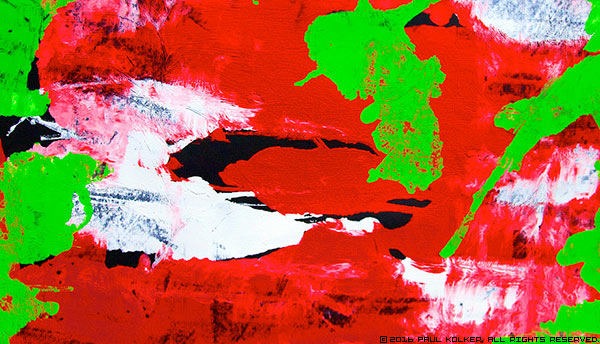
color, color decalcomania in green and red, op. 2, 2016 (detail)
acrylic on canvas
55 x 55 inches
Hering’s prescience of the opponent process was color perception genius; almost a century ahead of charge-coupled devices (CCDs) used in video cameras. Similarly, in human color perception, Hering’s coupled opposing charges from wavelength stimulated receptors for yellow in the retinal M cones which synapse in a part of the brain called the lateral geniculate nucleus (LGN). The LGN serves as an organic perceptual router, merging pathways from the retinal cones, (color receptors), and rods, (luminosity receptors). The wavelengths of violet to blue stimulate the L cones; red stimulates the S cones; green and yellow the M cones; and black and the luminosity of white stimulate the rods, From the LGN the impulses radiate in pathways to parts of the brain that are involved with perception, proprioception, orientation, emotion, behavior, memory, cognition, insights and intuitions… and much more, including color vision in the optical cortex.
Paul Kolker (b. 1935) is a New York-based artist with doctorate degrees in medicine and law. He is a Fellow American College of Surgeons, Fellow American College of Legal Medicine and Emeritus Chief of Cardiothoracic Surgery at North Shore/ LIJ Glen Cove Hospital, having practiced cardiothoracic surgery on Long Island from 1969 to 2013. In October 2001 Kolker moved his Long Island studio to his current address in the Chelsea art district so that he could produce his works and curate his exhibitions as an experiment in perception. His studio and gallery have together become his laboratory in which the viewer is the measuring instrument for Kolker’s art as a perceptual experiment. Color, Color… One Next to the Other is Kolker’s fifty-sixth solo exhibition.
Paul Kolker: Color, Color… One Next to the Other, is on view at the Paul Kolker collection at 511 West 25th Street from January 19 through March 10, 2017. Paul Kolker: Abstract Decalcomania is ongoing at 600 Third Avenue.
